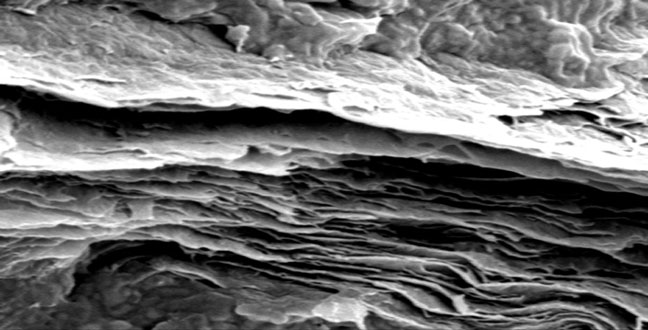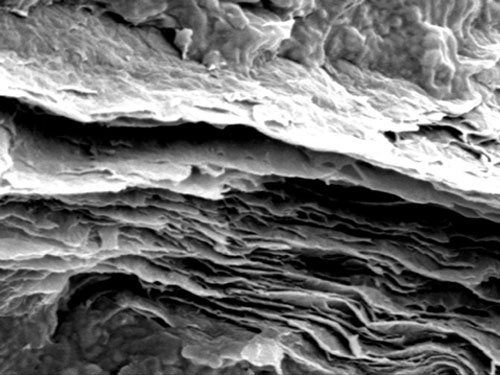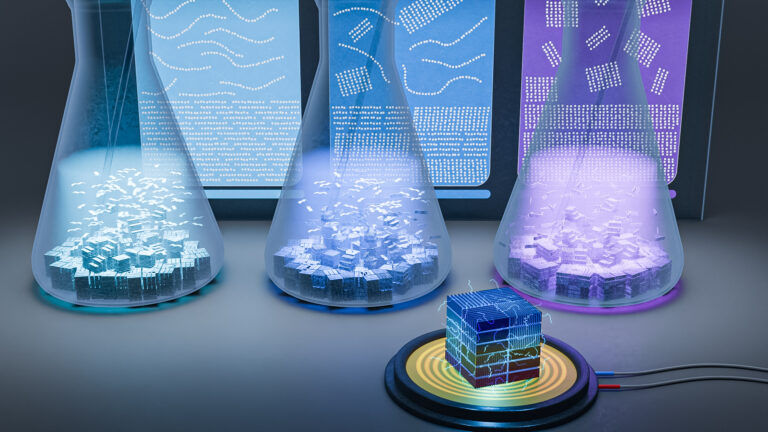Material Science and Engineering
Graphene is taking charge
Graphene-based capacitors prove useful in advanced non-linear electronics.


An electron microscope image of the graphene sheets used in the capacitors
© 2014 KAUST
Technology using graphene — a form of carbon comprised of a single atomic layer with unique electronic and mechanical properties — is being hailed in electronics as a potential successor to silicon technology. KAUST researchers have adopted graphene to produce a special type of capacitor that may power future electronics.
A fundamental component of an integrated circuit, the capacitor, has been around for hundreds of years. Despite this long history the humble capacitor still mystifies scientists. The function of a capacitor is to store electrical energy; but one key property is that the voltage lags behind the current by a quarter of an oscillation cycle, also known as a 90 degree phase lag. So a new type of capacitor in which the phase angle can be controlled — known as a fractional capacitor — will allow scientists to fine tune the relation between an alternating current and voltage in an electronic circuit to enable better dynamic control over both of them.
Fractional capacitors have been established in theory since the 1960s yet practical applications have been difficult to achieve. Potentially they would have widespread application in nonlinear electronic devices, such as neuromorphic circuits that emulate the function of the brain.
“Fractional capacitors can be used in situations which don’t suit conventional capacitors, which adds variety to the type and complexity of the circuits we can design,” explains Husam Alshareef, professor of material science and engineering.
Alshareef’s team demonstrated that graphene, with its atomically thin sheets, is ideally suited to act as a fractional capacitor. The researchers proved their design in which, embedded in a surrounding matrix of a polymer, the highly conductive graphene layers could store electrical charges to act as tiny capacitors within the surrounding polymer. The composite structure, made from many sheets layered together, then acts as a fractional capacitor.
Alshareef, together with Khaled Salama and their colleagues, were very excited about these results. Although fractional capacitors are not new, this research is the first demonstration of a compact, real world device.
“This design can be easily integrated on an electronic circuit board it will have many real world applications” says Alshareef. “Moreover, the patent-pending fractional capacitor is stable and functional up to low-MHz speeds which makes it much better than its predecessors. With further development, this new capacitor can make our everyday electronic gadgets that much more versatile, he adds
Alshareef explains that they are still working on the precise control of the lag between capacitor voltage and current away from 90 degrees. “This will require an accurate understanding and control of the graphene sheets in the device,” he says, which they are currently pursuing.
References
- Elshurafa, A.M., Almadhoun, M.N., Salama, K.N. & Alshareef, H.N. Microscale electrostatic fractional capacitors using reduced graphene oxide percolated polymer composites. Applied Physics Letters 102, 232901 (2013).| article
You might also like

Bioengineering
Smart patch detects allergies before symptoms strike

Applied Physics
Two-dimensional altermagnets could power waste heat recovery

Applied Physics
Interface engineering unlocks efficient, stable solar cells

Applied Physics
The right salt supercharges battery lifespan

Applied Physics
Light-powered ‘smart vision’ memories take a leap forward

Applied Physics
Natural polymer boosts solar cells

Material Science and Engineering
Hydrogels keep solar panels cool, efficient, and durable

Material Science and Engineering



